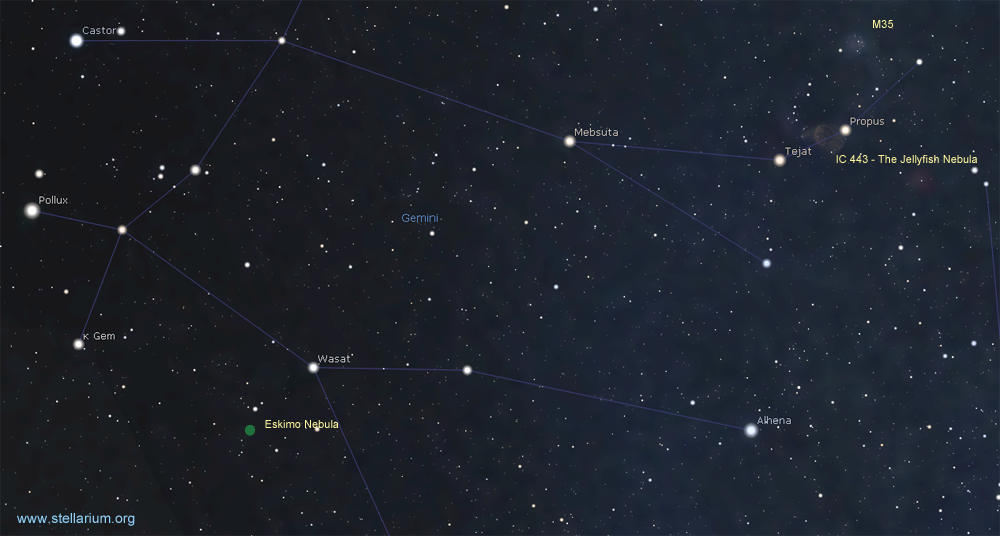Gemini Twins
Castor and Pollux are bright stars belonging to the constellation Gemini and are part of the dozen bright stars that light up the winter sky. They represent the heads of the twin which were half brothers as stated in mythology. Located 34 light-years away, Pollux is a magnitude 1.14 orange coloured star with a spectral class K0. Although Pollux has a diameter of 9 or 10 times that of our Sun, surface temperatures are 4,770 K and cooler than our Sun‘s 5,778 K. Pollux is in the process of fusing helium in carbon and oxygen in its core. It seems to have an outer corona comparable to our Sun. The exoplanet Pollux b resides 1.6 astronomical units from the parent star and takes 1.6 years to complete a circular orbit.
To the upper right of Pollux, we find Castor. This white coloured spectral class A1 star shines at magnitude 1.58 and is located 52 light-years from us. With a surface temperate about twice that of Pollux, Castor is a collection of three pairs of stars in a very unique dance. A telescope will show Castor’s close companion with both components Castor A & B are themselves doubles and possess a mysterious third double companion. Although components A & B orbit each other in 445 years, component C orbits A & B every 14,000 years.

One of the best examples of an open cluster is M35. Found near Castor’s foot, this group of 200 stars glows at magnitude 5.2 and is a fantastic object in binoculars. When viewed with a telescope, the tiny cluster NGC 2158 is now revealed. M35 is located 2,800 light-years away while smaller NGC 2158 is four times farther from us. Gemini is also home to the Eskimo Nebula1 also called the Clownface Nebula. With the catalogue number NGC 2392 or Caldwell 39, this bi-polar planetary nebula is estimated to reside 2,870 light-years from Earth. In small telescopes, the Eskimo appears as a fuzzy bright greenish object but larger instruments will reveal more detail. About 10,000 years ago a Sun-like star eventually ran out of fuel and grew to become a red giant. Over time the weak gravity allowed the release of its outer layers into space thus forming this celestial portrait.
Comet C/2018 Y1 (Iwamoto) was discovered by a Japanese astronomer in late 2018 is now racing through space at 66 km/sec. It passes close to the star Regulus in the constellation Leo on February 11 and this night along with the 12th will be the best nights to see and photograph it. Brightness estimates range from magnitude 7 to 7.8 at its best and safely passes the Earth at 45 million kilometres. Moonset on February 11 is before midnight local time and an hour later the next night.
The brilliant duo of planets Venus and Jupiter continue as Venus keeps sinking to the south-eastern horizon on its way to rounding the sun in its orbit. Venus passes the planet Saturn on the morning of the 18th. Jupiter, on the other hand, is steadily climbing higher and rises just before 4 a.m. on February 1 and after 2 a.m. on February 28. Mars is still visible low in the western sky after dark moving from Aries to Taurus and is much fainter than its summertime show. It passes one degree north of the planet Uranus on February 13.
For two weeks starting on February 21, look for the zodiacal light in the eastern sky before the sky lightens. From a dark location away from any light sources, you might see a slanted column of light close to Leo and along the ecliptic. This is the reflection of the leftover cosmic dust from our solar system. This light is seen close to spring and autumn.
The new moon is on February 4 and the full Snow moon is on the 19th.
Until next month, clear skies everyone.
Twitter: @astroeducator
1 was https://www.adamblockphotos.com/obs/n2392erickson.jpg
